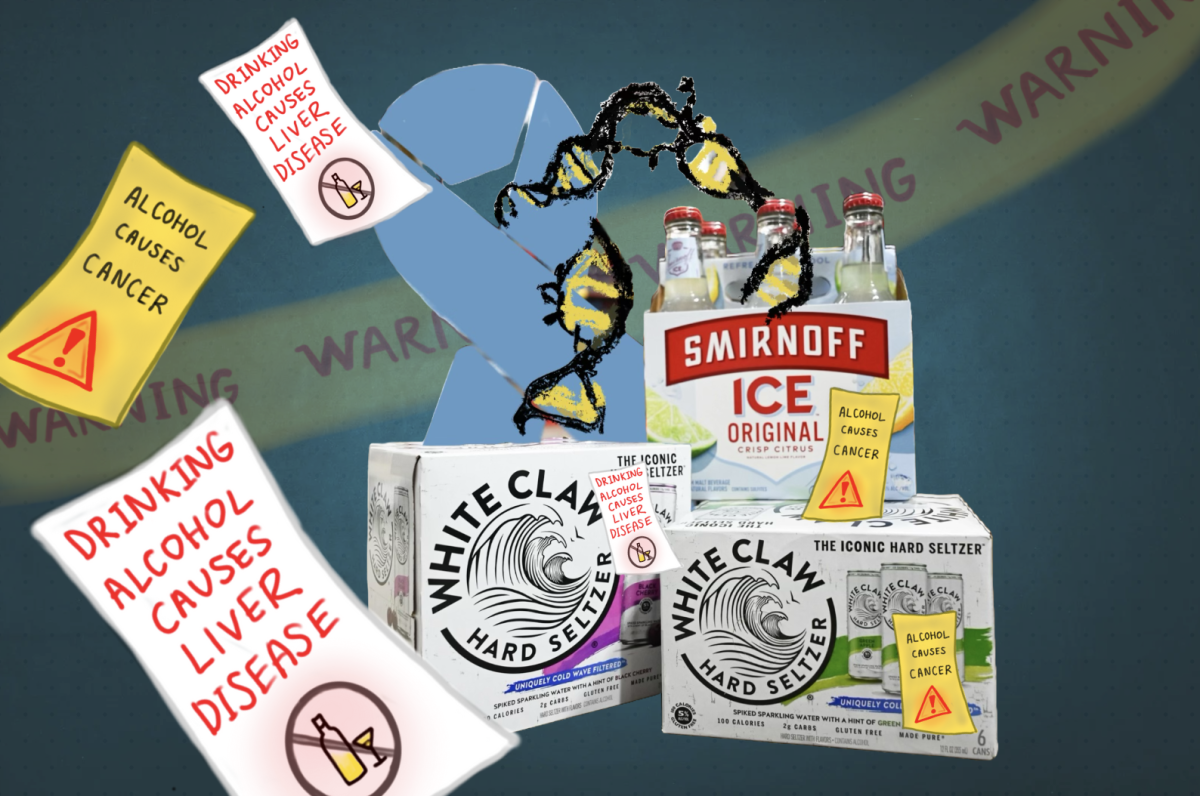The cancer risks of smoking are widely publicized—all cigarette packs contain warning labels detailing specific associated illnesses, and anti-smoking ads have become more common with the rise of e-cigarettes. But another carcinogen, just as deadly, remains largely ignored in public conversation: alcohol. With approximately 15% of American youth ages 12 to 20 reporting alcohol use—making it more prevalent than tobacco among adolescents—raising awareness about its cancer risks is also important.
Despite decades of research, less than half of Americans know that alcohol is a Group One carcinogen in the same category as tobacco and radiation, according to a recent advisory from the U.S. Surgeon General. The advisory calls for an explicit warning label on alcoholic beverages linking alcohol consumption to cancer, similar to the warning labels on tobacco products.
Medical Club co-president Kashish Priyam (12) highlights a growing awareness of alcohol’s true health risks, which extends beyond warning labels of packaging.
“Alcohol is so commonplace in our social interactions, so it’s very normalized in our world,” Kashish said. “Even though there have been studies showing that limited alcohol consumption may be good for your heart health or other things, a lot of those were faultily based, and there’s increasing evidence that alcohol has a tie with many different illnesses like cancer, so it’s raising a lot of questions.”
According to the U.S. Department of Health and Human Services, drinking alcohol increases the risk of at least seven types of cancer: mouth, throat, esophagus, voice box, breast and colon. When alcohol is consumed, the body metabolizes it into acetaldehyde, a highly toxic compound that damages DNA and prevents cells from repairing themselves properly. This can lead to mutations that trigger uncontrolled cell proliferation, which could ultimately result in cancer if left unchecked.
Upper school nurse Jennifer Olson explained how alcohol can disrupt hormone levels, another factor that increases cancer risk.
“What alcohol does over time is interrupt brain pathways, so that the brain is not functioning and the central nervous system isn’t doing what it’s supposed to be doing in the body,” Olson said. “So, that means your body could be either not releasing hormones effectively or overproducing hormones. It probably depends on the amount of alcohol and how long you’ve been drinking, whether or not you’re gonna have those long-term hormone fluctuations.”
Specifically, alcohol can alter our body’s levels of the hormone estrogen, which plays a vital role in the sexual and reproductive development of a woman.
“If you’re suppressing estrogen or producing too much estrogen, that would definitely be a cancer risk,” Olson said. “If you’re producing too much estrogen, you can get certain estrogen-driven cancers that can come from that— breast cancer in particular. There are quite a few different kinds of breast cancers, but about 80% of them are estrogen-driven.”
Consuming alcohol, especially on a regular basis, also poses significant risks to liver health. Research shows that nearly all heavy drinkers develop fatty liver, the earliest stage of alcohol-related liver disease caused by excessive fat buildup in the liver. More severe liver conditions caused by heavy drinking include alcoholic hepatitis and cirrhosis, both of which can be life-threatening.
“Your liver is the thing that processes alcohol in the body,” biology teacher Zane Moore said. “Drinking too much alcohol can actually kill and damage liver cells. Liver cells are pretty good at regenerating, but you can push that too far, to the point of even causing really nasty diseases like jaundice, which is the yellowing of the skin. That ultimately is liver disease.”
While alcohol poses health risks for adults and adolescents alike, young people are particularly vulnerable to cell damage, cancer and cognitive impairment due to their developing brains. The human brain continues developing until the mid-20s, particularly in areas responsible for decision-making and impulse control. Alcohol disrupts this process by interfering with neurotransmitters.
“Alcohol in itself is a drug that affects your neurology,” Kashish said. “When your brain is still developing—specifically your prefrontal cortex, which develops until you’re about 25 years old—drinking alcohol hinders your decision-making not only in the moment, but changes the way that your neurons interact with each other. This can have long term developmental effects, especially if you repeatedly drink at a young age.”
While young people drink less frequently than adults, they tend to consume larger amounts per occasion. About 91% of the alcohol consumed by youth comes from binge drinking episodes, a result of how their bodies metabolize alcohol.
“Young people also metabolize alcohol very quickly, so they can end up over-drinking because they don’t feel an effect right away,” Moore said. “Even if it’s not affecting your head, the amount of alcohol you consume as a young person, if you’re metabolizing it really quickly, still produces toxic metabolites that your body has to process.”
The legal drinking age of 21 in the U.S. is not arbitrary—it was deliberately chosen to protect brain development and reduce the risks associated with early alcohol consumption. The combination of binge drinking and early exposure to alcohol causes irreversible harm to an adolescent’s brain structure and function, and it may also raise cancer risks later in life.
“Individually, it’s really about understanding your body and understanding the people you surround yourself with,” Kashish said. “The habits you create for yourself will have a large impact on your health. It’s not just a one night thing, it will create patterns over time.”


















![“[Building nerf blasters] became this outlet of creativity for me that hasn't been matched by anything else. The process [of] making a build complete to your desire is such a painstakingly difficult process, but I've had to learn from [the skills needed from] soldering to proper painting. There's so many different options for everything, if you think about it, it exists. The best part is [that] if it doesn't exist, you can build it yourself," Ishaan Parate said.](https://harkeraquila.com/wp-content/uploads/2022/08/DSC_8149-900x604.jpg)




![“When I came into high school, I was ready to be a follower. But DECA was a game changer for me. It helped me overcome my fear of public speaking, and it's played such a major role in who I've become today. To be able to successfully lead a chapter of 150 students, an officer team and be one of the upperclassmen I once really admired is something I'm [really] proud of,” Anvitha Tummala ('21) said.](https://harkeraquila.com/wp-content/uploads/2021/07/Screen-Shot-2021-07-25-at-9.50.05-AM-900x594.png)







![“I think getting up in the morning and having a sense of purpose [is exciting]. I think without a certain amount of drive, life is kind of obsolete and mundane, and I think having that every single day is what makes each day unique and kind of makes life exciting,” Neymika Jain (12) said.](https://harkeraquila.com/wp-content/uploads/2017/06/Screen-Shot-2017-06-03-at-4.54.16-PM.png)








![“My slogan is ‘slow feet, don’t eat, and I’m hungry.’ You need to run fast to get where you are–you aren't going to get those championships if you aren't fast,” Angel Cervantes (12) said. “I want to do well in school on my tests and in track and win championships for my team. I live by that, [and] I can do that anywhere: in the classroom or on the field.”](https://harkeraquila.com/wp-content/uploads/2018/06/DSC5146-900x601.jpg)
![“[Volleyball has] taught me how to fall correctly, and another thing it taught is that you don’t have to be the best at something to be good at it. If you just hit the ball in a smart way, then it still scores points and you’re good at it. You could be a background player and still make a much bigger impact on the team than you would think,” Anya Gert (’20) said.](https://harkeraquila.com/wp-content/uploads/2020/06/AnnaGert_JinTuan_HoHPhotoEdited-600x900.jpeg)

![“I'm not nearly there yet, but [my confidence has] definitely been getting better since I was pretty shy and timid coming into Harker my freshman year. I know that there's a lot of people that are really confident in what they do, and I really admire them. Everyone's so driven and that has really pushed me to kind of try to find my own place in high school and be more confident,” Alyssa Huang (’20) said.](https://harkeraquila.com/wp-content/uploads/2020/06/AlyssaHuang_EmilyChen_HoHPhoto-900x749.jpeg)





